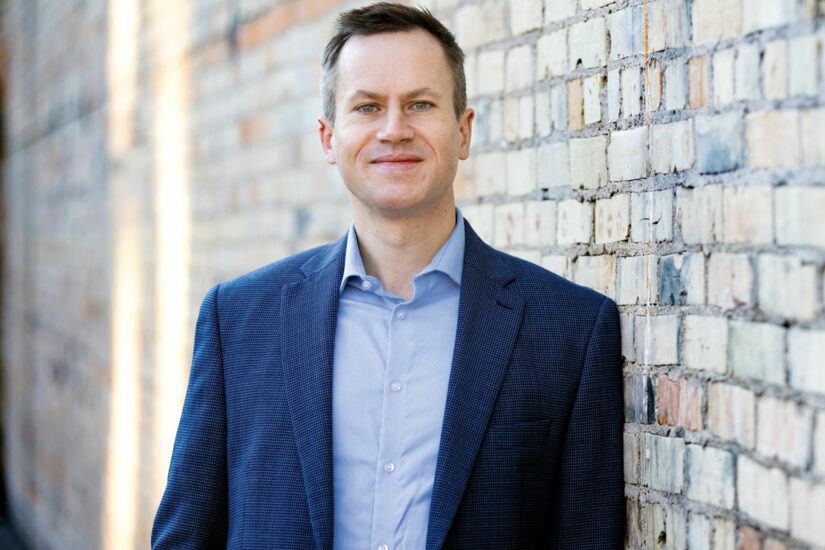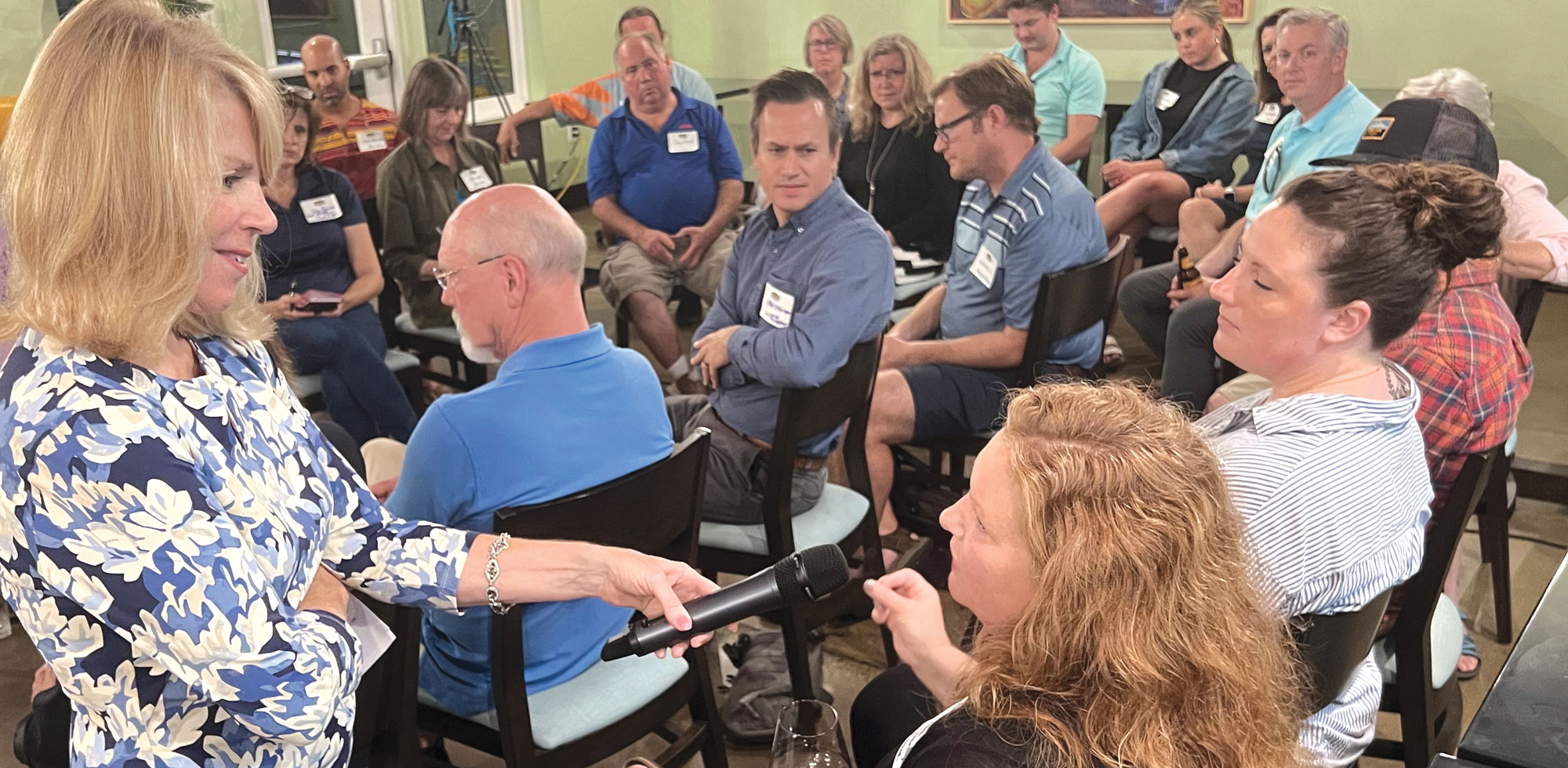
Leadership Through Listening
Incoming President Brian Voerding shares the Initiative Foundation’s vision for building community through solutions-based programs, engaged conversation and responsive grantmaking
By Laura Billings Coleman | Photography by Paul Middlestaedt
As a reporter and editor in a small town newsroom, Brian Voerding was a frequent practitioner of what he calls “grocery store journalism”—the certain knowledge that anything he printed in the Winona Daily News would soon be called to account by local readers who recognized him in the aisles of the frozen food section.
“The experience taught me how to listen to a community,” says Voerding, who was named president at the Initiative Foundation in November 2023. “Learning how to listen in a patient and welcoming way has served me well. If you talk to enough people, and listen really hard, you start to find out what a community’s needs are, what their concerns are, and I would say that’s a powerful part of the work we do at the Initiative Foundation.”
David Monroy, chair for the Initiative Foundation’s Board of Trustees, says Voerding’s capacity for engaged listening and asking the right questions helped him emerge as the top choice among a nationwide search of candidates to succeed former Foundation president Matt Varilek, who was appointed by Gov. Tim Walz in June 2023 to lead the Minnesota Department of Employment and Economic Development. “Since its start, the Initiative Foundation’s leadership has seen a continuity of excellent communicators, and those skills are evident with Brian,” says Monroy. “The work of the Initiative Foundation is easy to get your head and heart around, but when Brian talks about what’s possible for Central Minnesota, the passion really comes through.”
Raised in Montrose, a small community in Wright County, Voerding earned degrees in behavioral psychology and music from Hamline University, where he edited the weekly newspaper, The Oracle, by day, and hung out at local jazz clubs by night. After a few years as a Twin Cities freelance writer, Voerding moved to Winona, a Mississippi riverfront community of 25,000, to be with his now-wife Mollee Sheehan Voerding and two sons. He worked as a journalist, earned a master’s degree in organizational leadership at St. Mary’s University, and went on to launch Engage Winona, a nonprofit social-change and economic development organization serving the greater Winona area.
Voerding’s shift from newspapers to nonprofits got its start in a community-based leadership training session sponsored by the Blandin Foundation—a program not unlike some of the Initiative Foundation’s past and current community-building work. “That experience really unlocked my world,” Voerding says. “That experience unlocked my passion for empowering rural residents to engage with and envision the futures of their communities.”
Returning to his roots in Central Minnesota, Voerding joined the Initiative Foundation in June 2021 as its vice president for inclusive entrepreneurship, where he played a central role in two of the Initiative Foundation’s largest-ever grantmaking programs. He oversaw the 2021-2022 distribution of $8.8 million in COVID-era relief grants to 800 Central Minnesota small businesses. Voerding also helped to secure and implement a multi-million dollar effort supported by the Otto Bremer Trust that drove $1.1 million in transformative funding to nonprofits and an additional $700,000-plus to rural small and minority-owned businesses.
Seeing the impact of the Initiative Foundation’s work on multiple fronts during the pandemic—from supporting new childcare solutions to activating Central Minnesota’s increasingly diverse workforce to enhancing the leadership capacity of the region’s next generation of leaders—reinforced the value of the Minnesota Initiative Foundation model, a unique fusion of community lending, capacity building, and philanthropy found only in Minnesota. “I see the Initiative Foundation as a backbone support organization, walking alongside communities as they build the futures they want for themselves,” he says. “It requires a lot of listening, brainstorming, and consensus-building. But there’s a lot of joy in those conversations, too, because it’s all about building really vital and viable rural communities where people want to live, work and play, and contribute to lasting prosperity.”
With an election year on the horizon, we’re bound to hear more about the so-called “urban-rural divide.” As someone who grew up in Montrose, worked in the metro area, and is now living in St. Cloud, does that narrative make sense anymore?
Voerding: I think the urban-rural divide is an incomplete construct. The size or location of your community sometimes is not very descriptive for defining the kinds of issues we need to work on, or the kinds of conversations we need to move forward, not just in urban or rural areas, but as a state. When I was growing up, Montrose had a population of just 600 people. My parents worked in public schools their entire careers, and there was a lot of freedom and an enjoyable lack of supervision. In a lot of ways, it was the idyllic stereotype, but that’s not the only story. There’s a danger in thinking that small means unchallenged, or small means simple, because in fact, it can be a very complicated experience living in rural areas. They’re richly diverse in terms of politics, culture, geography, and social economics. All of these variables that communities are constructed around are often just as diverse as they would be in a larger community. At the same time, there are very distinct challenges and economic disparities when it comes to access and the equitable distribution of resources in rural places—the kinds of things that folks in other places may take for granted. Access to good, quality childcare is one of those challenges; an available workforce is another. I think our challenge in the rural areas and the more urban communities in Central Minnesota is to think about ways in which we can bring people more fully into relationships with each other so we can move forward collectively.
For many years, the Initiative Foundation has been exploring how to build a strong succession plan for Central Minnesota’s leaders, passing the baton from generation to generation. As the first millennial leader of the Foundation, what do you think the region needs to do to retain talent and promote opportunities for younger people?
Voerding: There used to be a narrative that to live in rural Minnesota meant making some kind of sacrifice—whether that’s arts and entertainment, access to diverse cultures and experiences, good restaurants, and interesting things to do. We used to have to tell these explicit narratives about how cool rural really is, but I think the pandemic tore that up, and I’m glad to see it. When I look at the huge assets we have to promote alongside all of the great cultural and quality of life experiences we have—affordable housing, easy transportation, access to the outdoors—living in a rural community is the very opposite of making a sacrifice. That said, it’s critical that we keep investing in the creativity, innovation and brain power of the people living in this region, which is one of the things the Initiative Foundation does really well.
During the pandemic, the Initiative Foundation delivered an incredible amount of resources to communities, including more than $16 million in relief grants to more than 1,500 businesses across Central Minnesota—almost a five-fold increase in the Foundation’s typical grantmaking volume. What lessons did you take away from that challenging time?
Voerding: The pandemic forced us to immediately elevate our game as a resource management and distribution channel for our region, as an intermediary for bringing lots of resources into the region, and as an administrator in effectively and equitably distributing dollars across our region. But at its core, it was all about moving resources to communities that really needed them—at the very moment they needed them—and that’s the work the Initiative Foundation has done for decades. You would never want to ask for a crisis of that scale, but what the pandemic revealed was the strength of the relationships and the working connections that the Initiative Foundation has developed over the years. While that level of grantmaking is a role that’s come and gone for us now that the pandemic has waned, there’s still a lot of power in recognizing our ability to do that work when it matters most, in a moment of crisis.

With programs for community building, philanthropy, nonprofit support, childcare and workforce solutions, along with entrepreneurship, the Initiative Foundation wears a lot of hats. How do you see the Foundation’s role in the region, and what challenges and opportunities do you see ahead?
Voerding: I like to say we’re unapologetically complicated. We have an expansive mission built around economy, community and generosity, which I think is a really nice framework for how to build vital rural communities.
The Minnesota Initiative Foundations got their start nearly 40 years ago, in the wake of a rural economic crisis, and we’re designed to be incredibly responsive to the communities we serve. Our aim is to deliver the right resources at the right time and to support communities that are creating the futures they want. That means embracing complexity and figuring out what we need to build for ourselves as an organization to really best serve our communities. Right now, our entrepreneurship program is growing and well regarded; our lending program is growing; our nonprofit development work is relatively unmatched at the local and even state level; and our Partner Fund program is viewed as the place where local people can join with us to create charitable funds that keep wealth local to support the health and prosperity of the region. We aren’t just one thing. We have to be diverse, because there are so many different needs to fill.
I see the Initiative Foundation as a resource magnet, striving for and being a strong advocate for state and federal dollars and philanthropic investments, delivering equitable resources that can help relieve some of the inequities we see in rural communities, and welcoming those resources back to Central Minnesota. I think this is strong positioning for the Initiative Foundation. The stronger the player and partner we can be in this space, through nonpartisan advocacy and facilitating conversations, the more successful we’ll be in fulfilling our mission to empower people throughout Central Minnesota to build a thriving economy, vibrant communities, and a lasting culture of generosity.